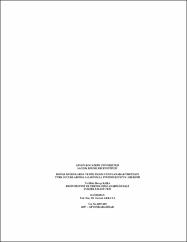Doğal Koşullarda ve Isıl İşlemi Uygulanarak Üretilen Türk Sucuklarında Salmonella Typhımurıum’un Gelişimi
Abstract
Yapılan bu çalışmada doğal koşullarda ve ısıl işlem uygulanmış Türk sucuklarında S.
typhimurium’un canlı kalma süresi araştırılmıştır. Bu amaçla hazırlanan sucuk hamuruna 104
kob/g ve 106 kob/g düzeylerinde S. typhimurium (NCTC-12416) inokule edilmiş, fermantasyon
(A1 ve A2; 104 kob/g ve 106 kob/g S. typhimurium NCTC-12416 inokulasyonu) ve ısıl işlem (B1
ve B2; 104 kob/g ve 106 kob/g S. typhimurium NCTC-12416 inokulasyonu) uygulamalarıyla
deneysel olarak sucuklar üretilmiştir. Doğal koşullarda üretilen sucuklardan inokulasyon sonrası,
dinlendirme sonrası ile fermantasyonun 3, 7 ve 12., depolamanın ise 30 ve 45. günlerinde; ısıl
işlem uygulanarak üretilen sucuklardan da inokulasyon sonrası, dinlendirme sonrası, ısıl işlem
sonrası ve depolamanın 3. gününde örnekler alınmıştır. Doğal koşullarda üretilen sucuklarda A1
grubunda fermantasyonun 7. gününde; A2 grubunda depolamanın 30. gününde S. typhimurium
sayısı <log 2,00’den az olduğu; aynı gün zenginleştirme yöntemiyle yapılan ekimlerde S.typhimurium’un var olduğu tespit edilmiştir. A1 grubunda fermantasyonun 12. gününde, A2
grubunda da depolamanın 45. gününde S. typhimurium izole edilememiştir. Isı işlem uygulanan
sucuklarda B1 ve B2 gruplarında ısıl işlem sonrası S. typhimurium’un <log 2,00’den az olduğu;
aynı gün yapılan zenginleştirme yönteminde ise var olduğu belirlenmiştir. Aynı grup sucuklarda
her iki inokulasyon seviyesinde de depolamanın 3. gününde S. typhimurium izole edilememiştir.
Yapılan bu araştırmada doğal koşullarda üretilen Türk sucuğu ortamında 104 ve 106 kob/g
değerlerinde inokule edilen S. typhimirium (NCTC-12416)’un, 4,75-5,06 pH aralığında ve
+4oC’de, 12-45 gün depolamada canlılığını yitirdiği; 68 oC’de 10 dk uygulanan ısıl işlemin ise S.
typhimirium’u elimine etmede yetersiz olduğu tespit edilmiştir. Sonuç olarak doğal koşullarda
üretilen ve ısıl işlem görmüş Türk sucuğu prosesinde üründe güvenliği gerçek manada garanti
altına alacak ve tüm proseste etkili olacak bir kontrol sistemi olan tehlike analiz ve kritik kontrol
noktaları (hazard analysis and critical control point, HACCP) sisteminin ham maddeden
başlayarak uygulanması, uygun teknolojik üretim tekniklerinin (good manufacture practis, GMP)
kurallarına uyulması önerilebilir. In this study, the survival of S. typhimurium was monitored in Turkish sausages produced by
traditional and thermal method. For this purpose, approximately 104 cfu/g and 106 cfu/g S.
typhimurium (NCTC-12416) was inoculated into sausage dough prepared previously and then
experimental sausages were made by traditional fermentation (A1 and A2; inclusion of 104 and
106 cfu/g S. typhimurium NCTC-12416) and implementation of thermal method (B1 and B2;
inclusion of 104 cfu/g and 106 cfu/g S. typhimurium). Samples were taken after inoculation,
maturation period and on 3rd, 7th, 12th days of fermentation and 30th and 45th days of storage
period. Samples from the sausages produced by thermal method were taken after inoculation
period and on 3rd day of storage period. It was found out that the number of S. typhimurium was
less than <log 2,00 in group A1 on the 7th day of fermentation and in group A2 on the 30th day
of storage. It was confirmed that on the same day S. typhimurium existed in the sausages by
enrichment method. S. typhimurium was not isolated on the 12th day of fermentation in group
A1 and on the 45th day of storation in group A2. It was determined that S. typhimurium was less
than <log 2,00 in group B1and group B2 of the sausages on which thermal method was
implemented.It was again confimed that S. typhimurium existed after enrichment on the same
day. In the same group of sausages at both levels of inoculation, S. typhimurium was not isolated
on the 3rd day of storage. In this study, it was detected that S. typhimurium (NCTC-1216) which
was inoculated at the numbers of 104 and 106 cfu/g lost its ability to survive between pH 4,75-
5,06 during 12-45 days storage at +40C and the thermal process inplemented at 68oC for 10
minutes was inadequate to eliminate S. typhimurium. In conclusion it can be recommended that
Hazard Analysis and Critical control points (HACCP) system which will ensure the safety of the
product and be effective in the whole process must be implemented and Good Manufacture
Practise (GMP) should be followed from the beginning of the process.
Collections
- Yüksek Lisans Tezleri [635]



















